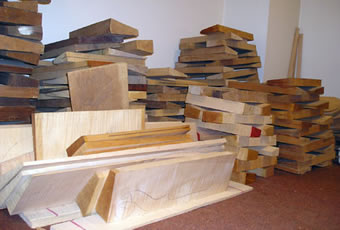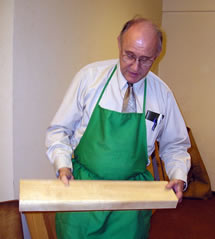Types of Wood Used for Making Violins
The woods most commonly used in violin making are Maple, Spruce, Ebony, Boxwood, Willow and Rosewood. Usually the back, ribs, neck and scroll are made of Maple while Spruce is used for the top, blocks, and linings. Ebony is used for the fingerboard, pegs, tailpiece, and end pin because it is the strongest of all light woods. Boxwood is sometimes substituted for Ebony because it is much easier to find. Many violin makers today are using North American broad leaf maple. This wood can produce as good of a sound as any if it is properly aged. and may add to the tonal quality.
 |
This picture shows the wood room at Peter Prier's violin shop. This wood, collected from around the world has been waiting for years to be made into a master violin. |
On cheaper violins, hardwood other than Ebony is used used for fingerboards and then dyed black. With constant use, however, they will wear down to a light or white color and look odd. In addition, these fingerboards soon develop ruts and buzzing noises. On collectors' and high-end instruments ivory trimmed pegs, tailpiece and end pin are common. These marks of distinction are much more expensive, but don't necessarily stand the test of time and abuse as does the Ebony.
Finding the Best Wood for Making Violins
Wood that is cut into billets, stickered, and air (aged away from rain and sun) is the best wood for creating violins. European maple from the Yugoslav area that is well figured, aged, and properly cut is considered prime. However, since the Maples of the area have long since been exhausted. Luthier Ralph Tiebout suspects that perhaps modern European suppliers may actually import wood from North America, and then age, cut, and billet it for resale to violin makers over the world who have grown accustomed to thinking European wood is the best. While there is no evidence for this claim, Tiebout explains that the wood he received fifty years ago from European sources was quite different than that of today. In the past European wood was white and much lighter and denser than it is today. North American wood is characteristically yellower or pinker and densier. However, instead of worrying about where the wood originated, violin makers should be careful to buy wood that is the lightest in weight and color and has the most attractive figuring.
| Peter Prier shows a piece of wood that he will soon make into a violin. This wood has been aging for many years now. |
 |
The flames, curls, and figuring of the wood is a subject on which many luthiers differ. Many violin makers feel that the figure of the wood has little to do with the sound it produces. By observing violins of master luther's, such as Stradivari, Amati, and Guarneri, you will notice some instruments that are strongly figured and others that are not. The age and density of the wood is more important than the figure when it comes to sound quality. However, a beautiful piece of wood does help sell the instrument and also gives it a permanent identification against fraud. While labels can be changed in old instruments, the wood and craftsmanship cannot. Highly figured wood requires greater care in working it for it tends to tear more easily. Figured maple, for example, is challenging when it comes to carving scrolls, graduating plates, perfecting arching, or letting-in perfling. Matching the figure and grain of the maple parts of the violin gives the instrument a visually unity that is very attractive. Thus, it is best to buy wood that is light, white, and has a figure that is visually pleasing.
Sound Production
While the wood used on the back and other parts of the violin may not make a great difference in the sound of the instrument, the top is another matter. It is conceded that the quality of sound is more greatly affected by the top than the back. There are differing opinions on this as well, but the quality of the top wood, usually Spruce, does seem to effect the tone greatly. While the one-piece back is often found, a one-piece top is rare. This is because of the grain of spruce is wider at the bark side and narrower at the heart side oft he tree. Thus, if a single piece of wood is split and glued back side to bark side, the acoustical properties of the wood should be approximately equal on both sides of the center line where it is glued. I seek wood that is light in weight, properly aged with the grains spaced roughly. 75 mm apart through the center (wider at the edges). Wood that shows the least variation space across the top is good. Experience teaches that a desirable piece of wood in the rough, suspended by a corner and tapped with the knuckles, rings clearly and with a rather high tone. This is not something that can be taught in a wood. However, with a little practice it becomes easy to recognize which piece of wood rings loud and clear and which is dull and muffled.

